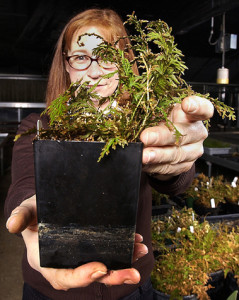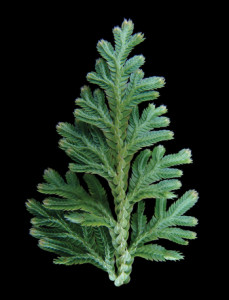WALNUT CREEK, Calif.— It’s not quite Christmas, but the DNA sequence of a small plant that resembles the seasonal conifers is providing biofuels researchers with information that could influence the development of candidate biofuel feedstock plants and offering botanists long-awaited insights into plant evolution.
“When you burn coal, you’re burning Selaginella’s ancestors,” said Purdue University botanist Jody Banks, who originally proposed that the U.S. Department of Energy (DOE) Joint Genome Institute (JGI) sequence the plant more commonly known as spikemoss as part of the DOE JGI’s 2005 Community Sequencing Program.
Published online May 5 in Science Express, a team of researchers from over 60 institutions, that included DOE JGI’s Dan Rokhsar and Igor Grigoriev, the senior authors of this work, reported the genome sequence of Selaginella moellendorffii and used a comparative genomics approach to identify the core genes that are likely to be present in a common ancestor to land plants.
Grigoriev noted that the Selaginella genome helps fill in a large gap in plant evolution from the unicellular green alga Chlamydomonas, sequenced at the DOE JGI and published in 2007, to flowering plants with vascular systems. “Selaginella occupies a phylogenetically important position for which we had no reference,” he said. “On one end of the spectrum we had mosses such as Physcomitrella” — the first moss to have its genome sequenced and published by DOE JGI — “and on the other are angiosperms such as grasses including Brachypodium,” whose genome was published by DOE JGI last year.
Spikemoss stands tall like grasses, but because it diverged from flowering plants more than 400 million years ago, it doesn’t have the roots and leaves like later plants. To help understand these relationships, the researchers compared the genome of Selaginella against those of Chlamydomonas, Physcomitrella and 14 angiosperms (flowering plants), including Arabidopsis and rice to identify common genes.
Banks said having the spikemoss genome revealed that the transition from mosses to plants with vascular systems didn’t involve as many genes as going from a vascular plant that doesn’t produce flowers to one that does. “We have a much better idea with Selaginella which genes evolved only in angiosperms. Plants need vascular tissues to be tall, to transport nutrients from roots to leaves,” she said. “That’s fairly complicated, but it turns out that process just didn’t need that many genes compared to inventing flowers.”
To help vascular tissues to stay upright, plants rely on lignin, a polymer biofuels researchers are targeting for investigation because its rigid structure is challenging to break down, impeding their use as potential bioenergy feedstocks. Banks’ colleague Clint Chapple, a coauthor on the paper and a Purdue colleague, has been using the Selaginella genome to study the pathways by which three different types of lignin are synthesized in plants.

Jody Banks from Purdue’s 2005 news release announcing the CSP project
to sequence Selaginella (Purdue Agricultural Communication photo/Tom Campbell)
“What we learned is that Selaginella not only invented the S type of lignin independently, maybe even earlier, than angiosperms but that they go about doing it through a related but different chemical route,” Chapple said. He described a recent project [funded by the National Science Foundation] in which enzymes from the lignin-synthesizing pathway in Selaginella were used to modify the canonical lignin-producing pathway in Arabidopsis to produce the polymer. Having the genome sequence offers strategic research opportunities, he said. “We’ve known for some time that if you alter the lignin building blocks you can improve biomass for agricultural and industrial uses.”
Banks also noted that the Selaginella research community has grown up around the availability of the genome, which was made publicly available through the DOE JGI’s plant portal Phytozome in 2009. One metric she cites is the number of researchers who’ve contributed to the Selaginella Genomics wiki she helps maintain, whose existence spread solely by word of mouth. “There are more than 100 coauthors now just because people are interested in the genome,” she said. “There have been a large number of recent papers, all including Selaginella genes because it really helps the researcher understand the evolution of their favorite gene family. Selaginella represents a whole branch of the plant evolutionary tree that no one has sampled before, and it is really important. The lignin story is just one example.”
The U.S. Department of Energy Joint Genome Institute, supported by the DOE Office of Science, is committed to advancing genomics in support of DOE missions related to clean energy generation and environmental characterization and cleanup. DOE JGI, headquartered in Walnut Creek, Calif., provides integrated high-throughput sequencing and computational analysis that enable systems-based scientific approaches to these challenges. Follow DOE JGI on Twitter.
